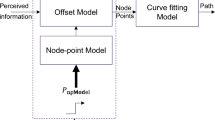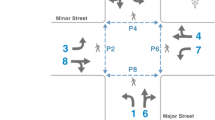Abstract
This paper describes a novel model known as the shadow obstacle model to generate a realistic corner-turning behavior in crowd simulation. The motivation for this model comes from the observation that people tend to choose a safer route rather than a shorter one when turning a corner. To calculate a safer route, an optimization method is proposed to generate the corner-turning rule that maximizes the viewing range for the agents. By combining psychological and physical forces together, a full crowd simulation framework is established to provide a more realistic crowd simulation. We demonstrate that our model produces a more realistic corner-turning behavior by comparison with real data obtained from the experiments. Finally, we perform parameter analysis to show the believability of our model through a series of experiments.
Similar content being viewed by others
References
Béhé, F., Galland, S., Gaud, N., et al., 2014. An ontologybased metamodel for multiagent-based simulations. Simul. Model. Pract. Theory, 40:64–85. http://dx.doi.org/10.1016/j.simpat.2013.09.002
Cui, Y., Qin, G., 2010. Intelligent path planning in 3D scene. Proc. Int. Conf. on Computer Application and System Modeling, p.579–583. http://dx.doi.org/10.1109/ICCASM.2010.5620400
Curtis, S., Snape, J., Manocha, D., 2012. Way portals: efficient multi-agent navigation with line-segment goals. Proc. ACM SIGGRAPH Symp. on Interactive 3D Graphics and Games, p.15–22. http://dx.doi.org/10.1145/2159616.2159619
Fiorini, P., Shiller, Z., 1998. Motion planning in dynamic environments using velocity obstacles. Int. J. Robot. Res., 17(7):760–772. http://dx.doi.org/10.1177/027836499801700706
Guy, S.J., Chhugani, J., Kim, C., et al., 2009. ClearPath: highly parallel collision avoidance for multi-agent simulation. Proc. ACM SIGGRAPH/Eurographics Symp. on Computer Animation, p.177–187. http://dx.doi.org/10.1145/1599470.1599494
Hashimoto, K., Yoshimi, T., Mizukawa, M., et al., 2013. A study of collision avoidance between service robot and human at corner—analysis of human behavior at corner. Proc. 10th Int. Conf. on Ubiquitous Robots and Ambient Intelligence, p.383–384. http://dx.doi.org/10.1109/URAI.2013.6677293
Helbing, D., Farkas, I., Vicsek, T., 2000. Simulating dynamical features of escape panic. Nature, 407(6803):487–490. http://dx.doi.org/10.1038/35035023
Jin, X., Xu, J., Wang, C.L., et al., 2008. Interactive control of large-crowd navigation in virtual environments using vector fields. IEEE Comput. Graph. Appl., 28(6):37–46. http://dx.doi.org/10.1109/MCG.2008.117
Kim, S., Guy, S.J., Manocha, D., 2013. Velocity-based modeling of physical interactions in multi-agent simulations. Proc. 12th ACM SIGGRAPH/Eurographics Symp. on Computer Animation, p.125–133. http://dx.doi.org/10.1145/2485895.2485910
Moussaïd, M., Helbing, D., Theraulaz, G., 2011. How simple rules determine pedestrian behavior and crowd disasters. PNAS, 108(17):6884–6888. http://dx.doi.org/10.1073/pnas.1016507108
Patil, S., van den Berg, J., Curtis, S., et al., 2011. Directing crowd simulations using navigation fields. IEEE Trans. Visual. Comput. Graph., 17(2):244–254. http://dx.doi.org/10.1109/TVCG.2010.33
Pelechano, N., Allbeck, J.M., Badler, N.I., 2008. Virtual Crowds: Methods, Simulation, and Control. Morgan & Claypool Publishers, USA. http://dx.doi.org/10.2200/s00123ed1v01y200808cgr008
Reynolds, C.W., 1999. Steering behaviors for autonomous characters. Game Developers Conf., p.763–782.
Rojas, F.A., Park, J.H., Yang, H.S., 2013. Group agent-based steering for the realistic corner turning and group movement of pedestrians in a crowd simulation. Proc. Computer Animation and Social Agents, p.1–4.
Shao, W., Terzopoulos, D., 2005. Autonomous pedestrians. Proc. ACM SIGGRAPH/Eurographics Symp. on Computer Animation, p.19–28. http://dx.doi.org/10.1145/1073368.1073371
Snape, J., Guy, S.J., Lin, M.C., et al., 2012. Reciprocal collision avoidance and multi-agent navigation for video games. Workshops at the 26th AAAI Conf. on Artificial Intelligence, p.49–52.
Snook, G., 2000. Simplified 3D movement and pathfinding using navigation meshes. Game Program. Gems, 1:288–304.
Thalmann, D., Grillon, H., Maim, J., et al., 2009. Challenges in crowd simulation. Proc. Int. Conf. on CyberWorlds, p.1–12. http://dx.doi.org/10.1109/CW.2009.23
van den Berg, J., Lin, M., Manocha, D., 2008. Reciprocal velocity obstacles for real-time multi-agent navigation. Proc. IEEE Int. Conf. on Robotics and Automation, p.1928–1935. http://dx.doi.org/10.1109/ROBOT.2008.4543489
van Toll, W.G., Cook, A.F., Geraerts, R., 2012. Real-time density-based crowd simulation. Comput. Animat. Virt. Worlds, 23(1):59–69. http://dx.doi.org/10.1002/cav.1424
Watt, A., 1993. 3D Computer Graphics. Addison-Wesley, UK.
Zhou, S., Chen, D., Cai, W., et al., 2010. Crowd modeling and simulation technologies. ACM Trans. Model. Comput. Simul., 20(4):20.1–20.35. http://dx.doi.org/10.1145/1842722.1842725
Author information
Authors and Affiliations
Corresponding author
Additional information
Project supported by the National Natural Science Foundation of China (Nos. 61170318 and 61300133), the Open Research Funding Program of Key Laboratory of Geographic Information Science, China (No. KLGIS2015A05), the Fundamental Research Funds for the Central Universities, China (No. 222201514331), and the Opening Project of Shanghai Key Laboratory of New Drug Design, China (No. 14DZ2272500)
ORCID: Gao-qi HE, http://orcid.org/0000-0001-8365-0970
Rights and permissions
About this article
Cite this article
He, Gq., Jin, Y., Chen, Q. et al. Shadow obstacle model for realistic corner-turning behavior in crowd simulation. Frontiers Inf Technol Electronic Eng 17, 200–211 (2016). https://doi.org/10.1631/FITEE.1500253
Received:
Accepted:
Published:
Issue Date:
DOI: https://doi.org/10.1631/FITEE.1500253




